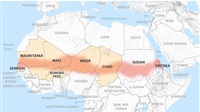Iran’s sleeper cell spy network made up of Hezbollah and IRGC

In the context of the Iranian regime's relentless pursuit to
extend its terrorist arms throughout the world, the Lebanese Hezbollah and the
Iranian Revolutionary Guards (IRGC), have intensified their activities against
the United States and other important foreign countries, serving as terrorist
groups that exercise the tasks of reconnaissance and gathering information
until they are instructed by Tehran to launch terrorist attacks, commonly in
the form of sleeper cells.
Dangerous cells
The danger of these cells comes after the Iranian regime failed
to avenge the death of Quds Forces commander Qassem Soleimani more than four
months ago, despite its many threats that the response would be seen around the
world. It has recently been revealed in the United States and European
countries that elements involved in those activities that would destabilize
international stability and security.
Iranian involvement
The Iranian regime has been involved in numerous attacks in
Western countries in recent decades, the most notable being the attacks it
launched in Argentina in the 1990s in response to the killing of Abbas Musawi,
then-secretary general of Hezbollah.
Sleeper network
In a recent report by two American researchers, they said
they found evidence that Iran and Hezbollah had established a sleeper network
in the United States and Europe that could be relied upon for Iranian
retaliatory attacks against Washington.
The study relied on court documents for some of these agents
who were arrested in the West. It pointed out that tasks range from
surveillance, logistical planning and forward operations, to camouflaging
activists, infiltration, recruitment and target selection.
Given the current data, it is unlikely that these sleeper
cells will carry out massive attacks, but lightning-fast and small attacks
instead. However, this carries meaningful threats to the United States on its
soil without being so provocative that Washington responds in the way of
revenge for the killing of Soleimani in a US strike in January, when Tehran
launched several missiles at US bases in Iraq. It was announced that about 80
American soldiers fell during these strikes, after which it became clear that
some of the missiles launched had landed inside Iran, while others landed in
the Iraqi desert, and therefore did not kill even a single US soldier.







